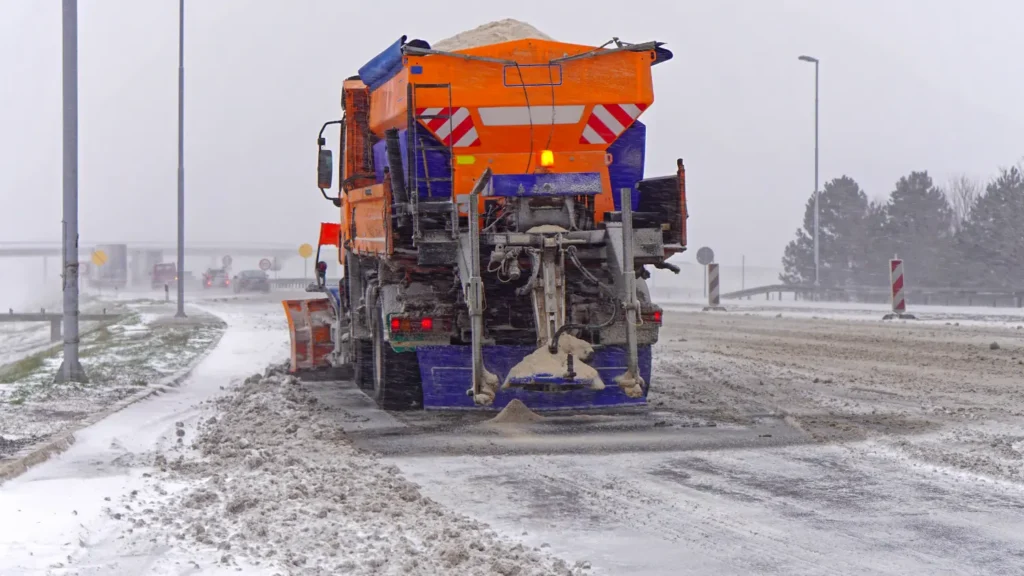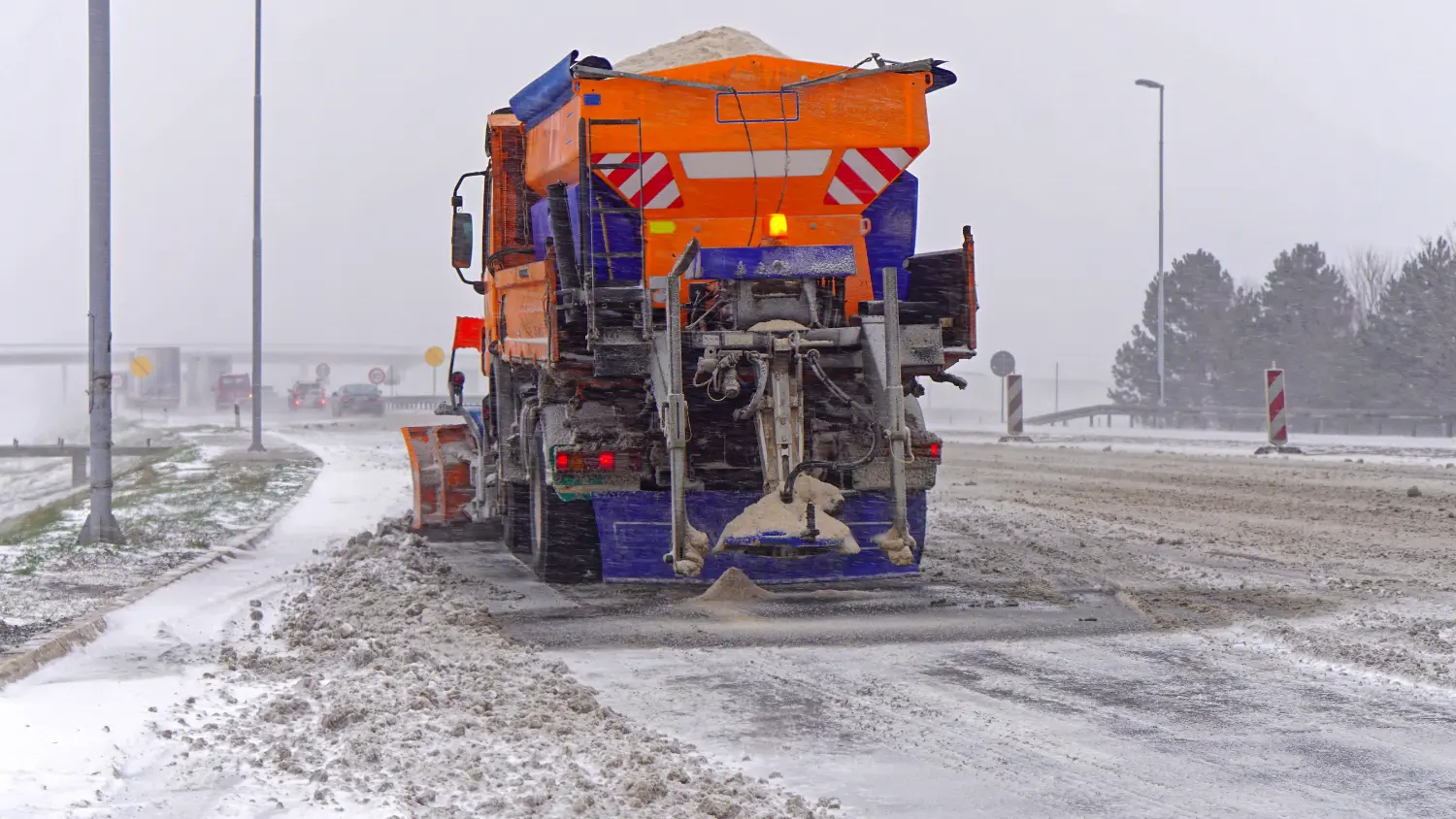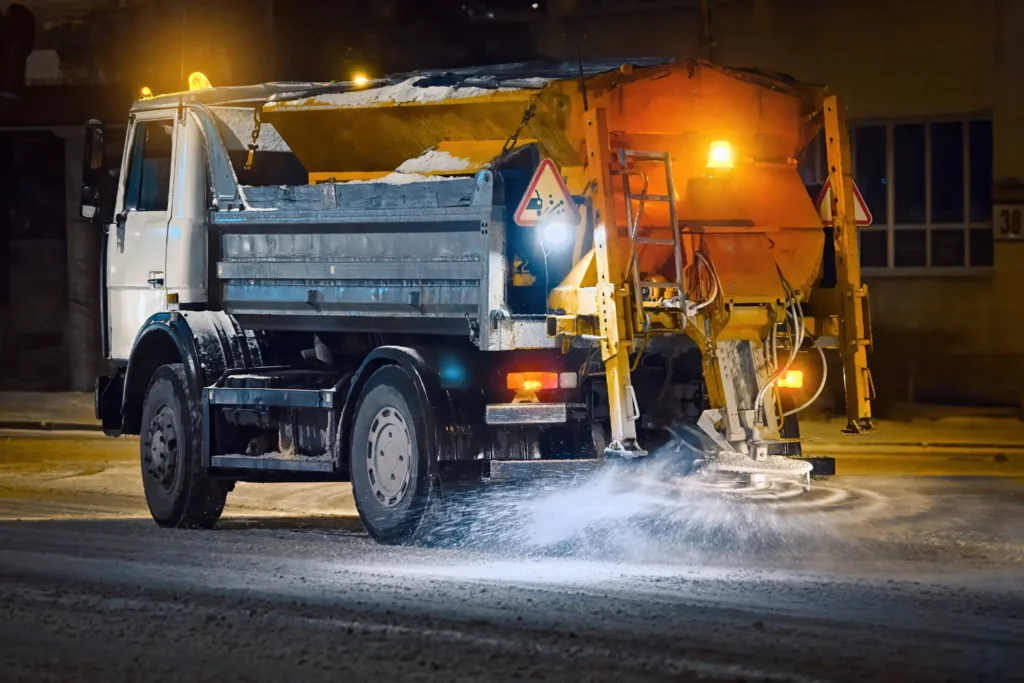Gritting is a vital process for ensuring road safety during the winter season. As temperatures drop and snowfall becomes more frequent, gritting crews and gritting vehicles work tirelessly to spread salt on roads, car parks, and pedestrian areas to prevent accidents and maintain mobility.
Gritting involves using rock salt to melt ice and lower the freezing point of water on the road surface. This process is essential for keeping priority routes, including major highways and busy intersections, passable during icy conditions. However, several myths about gritting can lead to misunderstandings about its effectiveness and application.
Common myths, such as the belief that gritting prevents all ice and snow from forming or that roads are only gritted after snowfall, can create a false sense of security. It’s important to understand the limitations and real benefits of gritting to appreciate the efforts of gritting crews and make informed decisions while navigating winter roads.
Common Gritting Myths Debunked
Myth 1: Gritting Prevents All Ice and Snow from Forming
One common myth is that gritting completely prevents ice and snow from forming on roads. While gritting is effective, it has its limitations. The primary purpose of spreading salt is to lower the freezing point of water, helping to melt ice and clear snow. However, in severe weather conditions with heavy snowfall or extremely low temperatures, even treated roads can still experience ice and snow accumulation.
Rock salt works by dissolving into the moisture on the road surface, forming a brine that helps to melt ice. But if the temperature drops too far below freezing, the effectiveness of the salt diminishes. This is why continuous monitoring and reapplication by gritting crews are essential during prolonged cold spells.
Myth 2: Roads Are Only Gritted After Snowfall
Another widespread myth is that gritting crews only spring into action after it starts snowing. In reality, gritting routes are often pre-treated before snow and icy conditions occur. This proactive approach helps prevent the initial build-up of ice and snow, making it easier to maintain clear roads as the weather deteriorates.
Priority routes, which include major roads, highways, and critical infrastructure areas, are usually the first to be treated. Gritting vehicles are dispatched based on weather forecasts and road temperature data to ensure these routes are prepared ahead of time. This pre-emptive gritting is crucial in minimising the impact of snow and ice on the road network.
Myth 3: Once a Gritter Has Passed, the Road Is Safe to Drive On
A common misconception is that once a gritting vehicle has passed, the road is immediately safe to drive on. While gritting significantly improves road conditions, several factors can influence its effectiveness, such as road surface temperature, air temperature, wind speed, and traffic levels.
For instance, if the road surface temperature is too low, the salt may not be as effective in melting ice. Additionally, high winds can blow the salt off the road before it has a chance to work. It’s also important to note that the full benefit of spreading salt is often realized through the action of traffic, which helps to spread and embed the salt into the road surface.
Understanding these nuances helps drivers and pedestrians make safer decisions during winter months, even on roads that have been gritted.
The Science Behind Gritting
Rock salt, the most commonly used material for gritting, plays a crucial role in managing ice and snow on roads. When salt is spread on the road surface, it dissolves into any moisture present, forming a brine solution. This brine lowers the freezing point of water, meaning it has to be much colder for ice to form. This process helps to melt ice already on the road and prevents new ice from forming, making roads safer for vehicles and pedestrians.
The effectiveness of rock salt is heavily influenced by the temperature. At higher temperatures (just below freezing), salt works quickly to melt ice. However, as temperatures drop, the process slows down, and below a certain point (around -10 degrees Celsius), salt becomes much less effective. This is why gritting is often supplemented with other treatments in extremely cold conditions.
The Impact of Air Temperature and Road Surface Temperature
Both air temperature and road surface temperature are critical factors in the gritting process. While air temperature gives a general idea of the conditions, the road surface temperature is more directly relevant to whether ice will form or melt. Road surface temperature can vary significantly from air temperature due to factors such as sunlight, road composition, and the presence of vehicles.
Gritting crews use specialized equipment to measure road surface temperature and determine the optimal times to spread salt. This data helps in making informed decisions about when and where to deploy gritting vehicles to maximize the effectiveness of the treatment.
The Role of Traffic in Spreading Salt
Traffic plays an essential role in enhancing the effectiveness of gritting. When vehicles drive over salted roads, their tyres help spread the salt across the surface and grind it into the ice, accelerating the melting process. This is why busy roads often clear faster than less-travelled routes.
However, heavy traffic can also pose challenges. During severe weather, traffic congestion can hinder the movement of gritting vehicles, delaying treatment. Therefore, gritting operations are carefully planned to manage both the timing and logistics of salt spreading.
Understanding the science behind gritting helps one appreciate its complexity and importance in maintaining road safety during winter weather.
Gritting Operations and Challenges
Gritting vehicles are specially designed to spread salt efficiently over large areas. Equipped with advanced GPS systems and sensors, these vehicles follow predefined gritting routes to ensure comprehensive coverage of priority routes and key road networks. The vehicles have large capacity hoppers to hold rock salt and are fitted with adjustable spreaders to control the amount and spread of salt being distributed.
Gritting crews are trained to operate these vehicles under challenging conditions. They often work in the early hours to prepare roads before peak traffic times. The coordination between the drivers, weather forecasters, and traffic management teams is critical to the success of gritting operations.
The Logistics of Planning Gritting Routes and Treatment Routes
Planning gritting routes involves careful consideration of various factors, including road types, traffic volumes, and weather conditions. Priority routes, such as major highways, critical intersections, and roads leading to emergency services, are given precedence. These routes are often treated multiple times during severe weather to ensure they remain passable.
Gritting routes are mapped out using interactive maps and data from previous winters. The goal is to maximize efficiency by covering the most critical areas first and ensuring that salt supplies are used effectively. Treatment routes are also planned for less critical areas, such as residential streets and car parks, although these may be gritted less frequently.
Challenges Faced by Gritting Crews During Severe Weather
Gritting crews face numerous challenges, particularly during severe weather events. Heavy snowfall, high winds, and freezing rain can create hazardous conditions that complicate gritting efforts. Snowfall can quickly cover treated roads, requiring repeated applications of salt and continuous monitoring of road conditions.
Another challenge is the variability in weather conditions. Rapid changes in temperature, moisture levels, and wind speed can affect the effectiveness of salt and the safety of gritting vehicles. Crews must be prepared to adapt to these changes, often working long hours in difficult conditions to keep roads clear.
Despite these challenges, gritting crews remain dedicated to their task, ensuring that the road network remains safe and accessible during the winter season. Their efforts play a crucial role in preventing accidents and keeping traffic moving, even in the harshest weather.

Wrapping Up: Understanding Gritting Myths and Realities
In this article, we’ve debunked some of the most common gritting myths and provided a deeper understanding of how gritting works to keep roads safe during the winter months. From the science behind rock salt to the logistics of planning gritting routes, we’ve highlighted the critical role that gritting crews and vehicles play in managing snow and ice.
To summarise, here are the three most important takeaways:
- Gritting is an essential process that lowers the freezing point of water on road surfaces, helping to melt ice and clear snow, though it has its limitations.
- Proactive gritting strategies ensure that priority routes are treated before severe weather hits, making roads safer for drivers and pedestrians.
- The effectiveness of gritting depends on various factors, including road surface temperature, air temperature, and traffic, which all influence how well the salt works to prevent icy conditions.
At AccuGrit, we specialise in comprehensive gritting and winter maintenance services to keep your roads, car parks, and pedestrian areas safe during the harshest winter conditions. Want to learn more about how we can help you navigate the winter season? Contact us today!
Don’t wait until winter weather strikes. Contact AccuGrit today to ensure your property is prepared and maintained throughout the winter months. Let us help you stay safe and confident on the road this winter.


